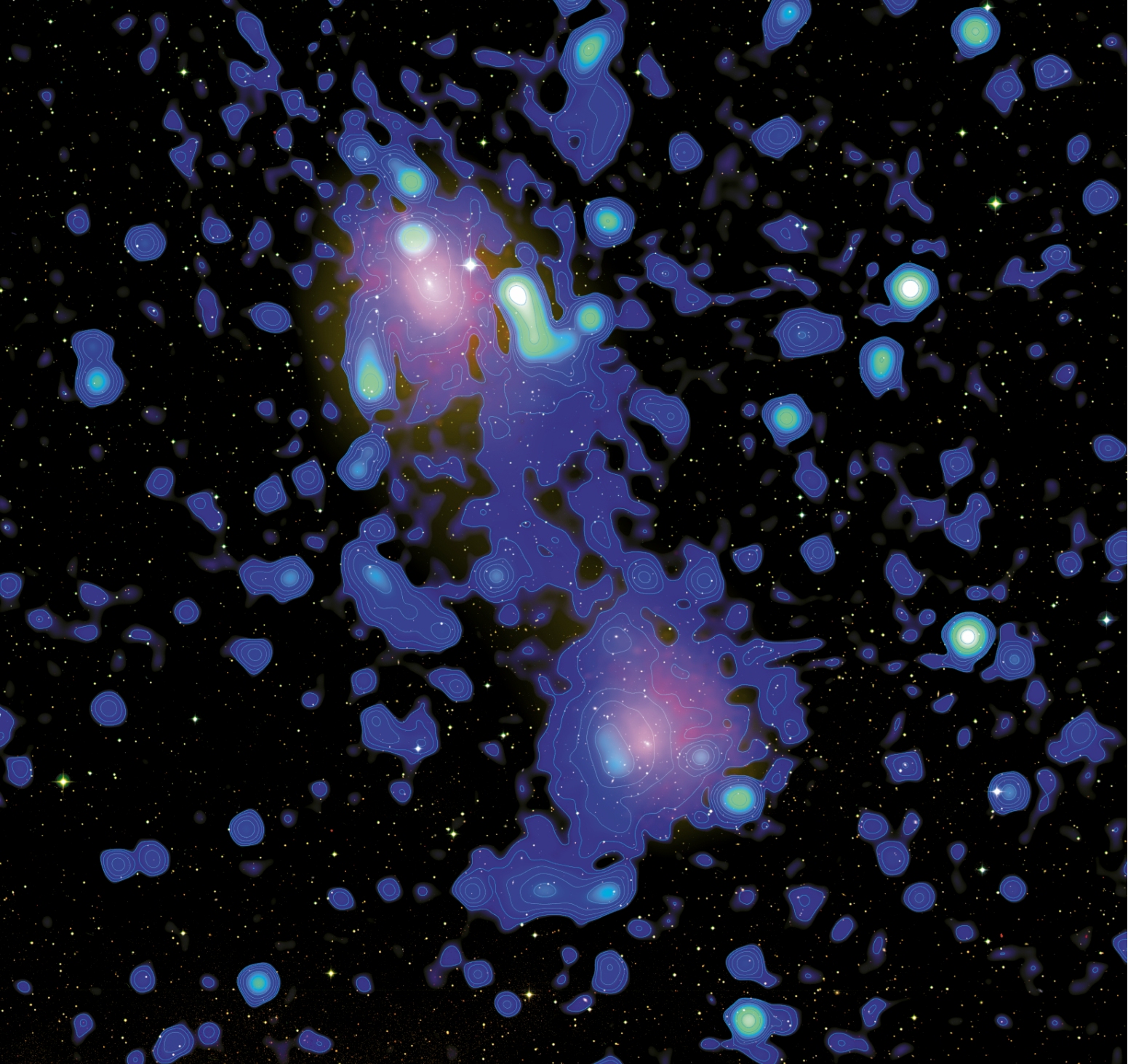Radio emission confirms that a magnetic field spans intergalactic space
DOI: 10.1063/PT.3.4264
Think of the large-scale universe as a web: Filamentary structures—threads of galaxies, gas, and dark matter—crisscross space. Where they intersect, gravitationally collapsing material forms galaxy clusters that can then merge through some still-unknown process. Some of the energy released by cluster mergers helps power relativistic particles that spiral around magnetic field lines.
One way that astronomers observe what happens during a merger is by detecting emissions that come from superheated plasma known as the intracluster medium (ICM). The density of the ICM is so low that the only way for matter to interact is through collisionless dealings between the plasma’s electric and magnetic fields. X rays are emitted from the interaction of the plasma’s electric field with free electrons; synchrotron radiation is emitted from cosmic-ray particles traveling through magnetic fields. (See the article by Lawrence Rudnick, Physics Today, January 2019, page 46
Astronomers have long wondered whether the radio emission from magnetic fields in clusters extends to the filamentary structures, which contain about half of the universe’s baryons. The detection of emission there would be a first step toward understanding the physical processes that affect those baryons, and it would confirm the cosmic web structure of the universe.
The effort to find emission associated with filamentary structures has come up short so far, although the presence of filaments has been inferred from the detection of UV absorption lines (see Physics Today, July 2008, page 12
Now radio synchrotron emission has been newly detected between two merging galaxy clusters by the Low Frequency Array (LOFAR) telescope. It was built and designed and is operated by the Netherlands Institute for Radio Astronomy with contributions from international partners. A collaboration led by Federica Govoni of Italy’s National Institute for Astrophysics has found that the synchrotron emission arises from a magnetic field that extends over distances greater than previously thought possible. 1
A European-sized radio dish
Measurements made before the new LOFAR observations led Govoni and her colleagues to suspect that a filamentary structure exists between the merging galaxy clusters Abell 0399 and Abell 0401. Figure
Figure 1.

A filamentary structure joins the merging galaxy clusters Abell 0399 and Abell 0401. The cluster positions are illuminated by x-ray observations (pink) collected by the European Space Agency’s (ESA’s) XMM-Newton observatory. The faint yellow around and between the clusters shows the filamentary structure inferred from microwave photon-intensity measurements collected by the ESA’s Planck satellite. The radio synchrotron emission (blue) detected using the Low Frequency Array telescope provides the first evidence for a previously unseen 3-megaparsec-long magnetic field connecting the clusters. (Image by M. Murgia, INAF.)

LOFAR was designed to detect ultralow-frequency radio emissions in the range of 10–250 MHz (see Physics Today, March 2011, page 24
Individual antennas far from each other create a long baseline that enables LOFAR to detect the faint radio energy emitted by distant planets, stars, galaxies, and clusters. Such a baseline can be used to produce sharp, highly resolved images. In the Netherlands, the antennas are spaced closely together, which provides an extended picture of the sky. The Dutch stations of the LOFAR array, one of which can be seen in figure
Figure 2.

The Low Frequency Array (LOFAR) telescope is a collection of 25 000 individual dipole antennas distributed among 51 stations across Europe. One of the densely spaced Dutch stations is shown here. Each antenna in the center group— a metal pole with wire mesh underneath—detects low-band frequencies in the range of 10–80 MHz. The other antenna groups are housed in aluminum tile boxes and detect high-band frequencies in the range of 120–240 MHz. (Photo by © Top-Foto, Assen.)

Before the researchers could make the successful detection, they had to synchronize and calibrate all the antennas. “It’s one of the most challenging parts for not only LOFAR but [all] low-frequency radio observations,” says x-ray astronomer Hiroki Akamatsu of the Netherlands Institute for Space Research. Charged particles in Earth’s ionosphere emit energy at frequencies that interfere with radio-astronomy telescopes. But in 2016 a team led by Reinout van Weeren of Leiden University in the Netherlands developed an effective calibration method for the LOFAR telescope that entails modeling the ionosphere and then removing its contribution from the radio-emission observations. 2
With the new calibration, the LOFAR community “can basically limit the effects of the ionosphere and see what is really happening above the atmosphere of the Earth,” says Wilber. “We made a lot of progress, and now we have very reliable results.”
The new LOFAR findings, the 140 MHz synchrotron emission shown in figure
Shocks to the system
Electrons in the magnetic field lose energy to synchrotron radiation and inverse Compton scattering over time. First-order calculations suggest that the electrons in the filament can therefore only travel at relativistic speed for 230 million years. At that rate, the maximum distance they could travel would be 0.1 Mpc, about one order of magnitude less than the length of the observed radio bridge. To get across the filament and its magnetic field, some mechanism acting along the entire cosmic-sized filament must accelerate the relativistic electrons to give them an extra boost.
To identify such a mechanism, one of Govoni’s coauthors, Franco Vazza of the University of Bologna in Italy, performed magnetohydrodynamic numerical simulations. 3 In the model, the particles in the filamentary structure are energized by shock waves produced from merging clusters. The first simulation accelerated a population of relatively young electrons to not-quite-relativistic speed for 230 million years. But the associated radio emission was about one-thousandth as intense as the LOFAR observations.
Electrons need a GeV of energy to radiate detectable synchrotron emission at radio frequencies. The shock waves were too small and inefficient to get the job done in the first simulation. The second one reasonably reproduced the LOFAR intensities by including an additional, preexisting population of billion-year-old relativistic electrons that get accelerated by stronger merger-induced shock waves.
Several details about the mechanism still need to be worked out. Govoni and her colleagues do not know yet where the old relativistic electrons come from nor what mechanism fills the filament with them. “It is important to understand whether the emission detected in the filament that connects Abell 0399 and Abell 0401 is a common phenomenon in the cosmic web,” says Govoni. “I hope that astronomers will soon find other magnetized filaments.”
References
1. F. Govoni et al., Science 364, 981 (2019). https://doi.org/10.1126/science.aat7500
2. R. J. van Weeren et al., Astrophys. J., Suppl. Ser. 223, 2 (2016). https://doi.org/10.3847/0067-0049/223/1/2
3. G. L. Bryan et al., Astrophys. J., Suppl. Ser. 211, 19 (2014). https://doi.org/10.1088/0067-0049/211/2/19
More about the Authors
Alex Lopatka. alopatka@aip.org
